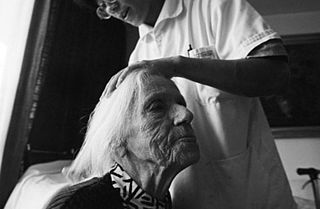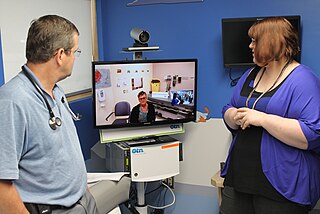Related Research Articles
Occupational therapists (OTs) are health care professionals specializing in occupational therapy and occupational science. OTs and occupational therapy assistants (OTAs) use scientific bases and a holistic perspective to promote a person's ability to fulfill their daily routines and roles. OTs have immense training in the physical, psychological, and social aspects of human functioning deriving from an education grounded in anatomical and physiological concepts, and psychological perspectives. They enable individuals across the lifespan by optimizing their abilities to perform activities that are meaningful to them ("occupations"). Human occupations include activities of daily living, work/vocation, play, education, leisure, rest and sleep, and social participation.

Home care is supportive care provided in the home. Care may be provided by licensed healthcare professionals who provide medical treatment needs or by professional caregivers who provide daily assistance to ensure the activities of daily living (ADLs) are met. In-home medical care is often and more accurately referred to as home health care or formal care. Often, the term home health care is used to distinguish it from non-medical care, custodial care, or private-duty care which refers to assistance and services provided by persons who are not nurses, doctors, or other licensed medical personnel. For terminally ill patients, home care may include hospice care. For patients recovering from surgery or illness, home care may include rehabilitative therapies.
Activities of daily living is a term used in healthcare to refer to people's daily self-care activities. Health professionals often use a person's ability or inability to perform ADLs as a measurement of their functional status. The concept of ADLs was originally proposed in the 1950s by Sidney Katz and his team at the Benjamin Rose Hospital in Cleveland, Ohio. The concept of ADLs has been added to and refined by a variety of researchers since that time. For example, many indexes that assess ADLs now include some measure of mobility. Additionally, to be more inclusive of the range of activities that support independent living, in 1969, Lawton and Brody developed the instrumental activities of daily living (IADLs). ADLs are often used in the care of people with disabilities, people with injuries, and the elderly. Younger children often require help from adults to perform ADLs, as they have not yet developed the skills necessary to perform them independently.

A nursing home is a facility for the residential care of elderly or disabled people. Nursing homes may also be referred to as skilled nursing facility (SNF), long-term care facilities, old people's homes, assisted living facilitiescare homes, rest homes, convalescent homes or convalescent care. Often, these terms have slightly different meanings to indicate whether the institutions are public or private, and whether they provide mostly assisted living, or nursing care and emergency medical care. Nursing homes are used by people who do not need to be in a hospital, but cannot be cared for at home. The nursing home facility nurses have the responsibilities of caring for the patients' medical needs and also the responsibility of being in charge of other employees, depending on their ranks. Most nursing homes have nursing aides and skilled nurses on hand 24 hours a day.

Telenursing refers to the use of information technology in the provision of nursing services whenever physical distance exists between patient and nurse, or between any number of nurses. As a field, it is part of telemedicine, and has many points of contacts with other medical and non-medical applications, such as telediagnosis, teleconsultation, and telemonitoring. The field, however, is still being developed as the information on telenursing isn't comprehensive enough.

A nurse practitioner (NP) is an advanced practice registered nurse and a type of mid-level practitioner. NPs are trained to assess patient needs, order and interpret diagnostic and laboratory tests, diagnose disease, formulate and prescribe treatment plans. NP training covers basic disease prevention, coordination of care, and health promotion, but does not provide the depth of expertise needed to recognize more complex conditions.
Home health nursing is a nursing specialty in which nurses provide multidimensional home care to patients of all ages. Home health care is a cost efficient way to deliver quality care in the convenience of the client's home. Home health nurses create care plans to achieve goals based on the client's diagnosis. These plans can include preventive, therapeutic, and rehabilitative actions. Home health nurses also supervise certified nursing assistants. The professional nursing organization for home health nurses is the Home Healthcare Nurses Association (HHNA). Home health care is intended for clients that are well enough to be discharged home, but still require skilled nursing personnel to assess, initiate and oversee nursing interventions.
Program of All-inclusive Care for the Elderly (PACE) are programs within the United States that provide comprehensive health services for individuals age 55 and over who are sufficiently frail to be categorized as "nursing home eligible" by their state's Medicaid program. The ultimate goal of PACE programs is to keep eligible older adults out of nursing homes and within their communities for as long as possible. Services include primary and specialty medical care, nursing, nutrition, social services, therapies, pharmaceuticals, day health center services, home care, health-related transportation, minor modification to the home to accommodate disabilities, and anything else the program determines is medically necessary to maximize a member's health. If you or a loved one are eligible for nursing home level care but prefer to continue living at home, a PACE program can provide expansive health care and social opportunities during the day while you retain the comfort and familiarity of your home outside of day hours.

Gerontological nursing is the specialty of nursing pertaining to older adults. Gerontological nurses work in collaboration with older adults, their families, and communities to support healthy aging, maximum functioning, and quality of life. The term gerontological nursing, which replaced the term geriatric nursing in the 1970s, is seen as being more consistent with the specialty's broader focus on health and wellness, in addition to illness.

Nursing is a profession within the health care sector focused on the care of individuals, families, and communities so they may attain, maintain, or recover optimal health and quality of life. They also take on vital roles of education, assessing situations, as support. Nurses may be differentiated from other health care providers by their approach to patient care, training, and scope of practice. Nurses practice in many specialties with differing levels of prescription authority. Nurses comprise the largest component of most healthcare environments; but there is evidence of international shortages of qualified nurses. Many nurses provide care within the ordering scope of physicians, and this traditional role has shaped the public image of nurses as care providers. Nurse practitioners are nurses with a graduate degree in advanced practice nursing. They are however permitted by most jurisdictions to practice independently in a variety of settings. Since the postwar period, nurse education has undergone a process of diversification towards advanced and specialized credentials, and many of the traditional regulations and provider roles are changing.
A professional live-in caregiver provides personal care and assistance to individuals, including those suffering from chronic illness, Alzheimer’s disease, and dementia, within the home setting. Typical duties of a live-in caregiver include meal planning and preparation, assistance with grooming, dressing and toileting, medication management, laundry and light housekeeping, and transportation/escorts to doctor’s appointments or social engagements. Professional live-in caregivers are often provided by an outside agency, which may also coordinate their services with the client’s preferred in-home health agency and other medical providers.
Unlicensed assistive personnel (UAP) are paraprofessionals who assist individuals with physical disabilities, mental impairments, and other health care needs with their activities of daily living (ADLs). UAPs also provide bedside care—including basic nursing procedures—all under the supervision of a registered nurse, licensed practical nurse or other health care professional. UAPs must demonstrate their ability and competence before gaining any expanded responsibilities in a clinical setting. While providing this care, UAPs offer compassion and patience and are part of the patient's healthcare support system. Communication between UAPs and registered nurses (RNs) is key as they are working together in their patients' best interests. The scope of care UAPs are responsible for is delegated by RNs or other clinical licensed professionals.

Independent senior living communities are housing designed for seniors 55 and older.

Telehomecare (THC) is a subfield within telehealth. It involves the delivery of healthcare services to patients at home through the use of telecommunications technologies, which enable the interaction of voice, video, and health-related data. The management of care is done from an external site by a healthcare professional.

Founded in 1975, Bayada Home Health Care is an international nonprofit home health care provider. BAYADA has more than 360 offices in 23 states, with locations in Germany, India, Ireland, New Zealand, and South Korea.
Sidney Katz, MD was a pioneering American physician, scientist, educator, author, and public servant who developed the Index of Independence of Activities for Daily Living (ADLs) in a career spanning more than sixty years. He made several other advances in geriatric care, including the U.S. Nursing Home Reform Act of 1987, which established basic rights for nursing home residents. Katz received several public and private awards, including the Maxwell A. Pollak Award (1993) and the American Geriatrics Society’s (AGS) Foundation for Health in Aging (2001). The AGS award was also won by former US President Jimmy Carter and poet Maya Angelou.
As of 2017, approximately 1.4 million Americans live in a nursing home, two-thirds of whom rely on Medicaid to pay for their care. Residential nursing facilities receive Medicaid federal funding and approvals through a state health department. These facilities may be overseen by various types of state agency.
Nestor Primecare Services Limited also known as Allied Healthcare was the UK's largest domiciliary care business and a leading provider of outsourced healthcare services to the English primary care sector.
Home care in the United Kingdom is supportive care provided in the home. Care may be provided by licensed healthcare professionals who provide medical care needs or by professional caregivers who provide daily care to help to ensure the activities of daily living (ADLs) are met. In home medical care is often and more accurately referred to as home health care or formal care. Often, the term home health care is used to distinguish it from non-medical care, custodial care, or private-duty care which is care that is provided by persons who are not nurses, doctors, or other licensed medical personnel.
Community nursing is nursing care delivered outside acute hospitals, for example in the home, within General Practice facilities, in community hospitals, in police custody, at a school or in a care home. In the UK, a community nurse needs a degree approved by the Nursing and Midwifery Council, as well as 1–2 years’ experience as a qualified Adult Nurse.
References
- ↑ "Home Care Services". medlineplus.gov. Retrieved 19 June 2020.
- ↑ Bolton, Sharon C.; Wibberley, Gemma (2013-10-31). "Domiciliary Care: The Formal and Informal Labour Process:". Sociology. doi:10.1177/0038038513500098.
- ↑ "In-Home Care Services for Seniors". Seniors. Retrieved 12 October 2017.
- ↑ "In-home care services definition". Aged Care Guide. Retrieved 19 June 2020.
- 1 2 Landers, Steven; Madigan, Elizabeth; Leff, Bruce; Rosati, Robert J.; McCann, Barbara A.; Hornbake, Rodney; MacMillan, Richard; Jones, Kate; Bowles, Kathryn; Dowding, Dawn; Lee, Teresa (2016-10-05). "The Future of Home Health Care". Home Health Care Management & Practice. 28 (4): 262–278. doi:10.1177/1084822316666368. ISSN 1084-8223. PMC 5052697 . PMID 27746670.
- 1 2 3 "Home Healthcare Nurse Careers and Salary Outlook | 2020 NurseJournal.org". NurseJournal. 2020-06-03. Retrieved 2020-07-17.